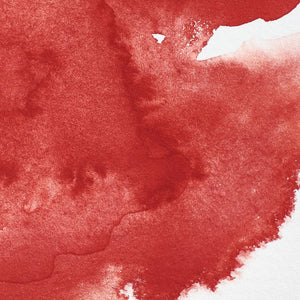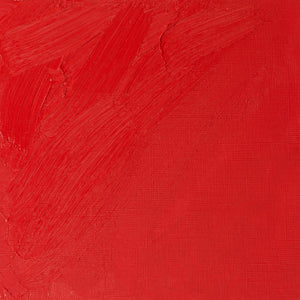
Think of the colour red and it’s most likely you will find yourself thinking of the big emotions. That’s why artists like it so much. Red is an extremely dominant colour and even a small piece in a painting will catch your attention. It is the colour most often associated with powerful feelings like love, passion and anger, as well as heat, fire and blood. Cadmium red is a very strong, warm and opaque red and in the early part of the 20th century it became a natural replacement for the distinctive but toxic vermilion.
Cadmiums have the broadest range of hues derived from any of the inorganic pigment groups. These hues range from pale to golden deep yellows, light, fiery oranges to deep ones, through to light, bright scarlets, deep reds and maroons.
The emergence of cadmium pigments
Cadmium is a moderately soft, silvery white metal with a melting point of just over 700 degrees Celsius. Cadmium compounds have been used as a source of colour since the discovery of cadmium in 1817 by the German chemist Friedrich Stromeyer. It was Stromeyer who first recommended the use of the bright yellow cadmium sulphide in artists’ colours – although in 1809, George Field, whose chemical colour work was highly influential at Winsor & Newton, mentions cadmium yellow for use in watercolour.
Cadmiums became more available to artists after commercial production began in Germany in the 1830s. Winsor & Newton showed cadmium yellow at the 1851 Crystal Palace exhibition. During this period cadmiums, although expensive, were highly valued for their permanence, brilliance, opacity and mixing capabilities.
The development of cadmium red
It was some time after the introduction of cadmium yellow that cadmium red began to appear. The early reds were made by heating the cadmium yellow together with selenium. In 1919 a patent was registered for the production of cadmium orange and cadmium red. The method for this production was to mix cadmium salt solutions with alkali and alkaline earth sulphides and, in turn, to heat the resultant precipitate. For those of us who might not have been paying attention in chemistry lessons, a precipitate is the solid material or collection of particles that is left in a solution after a chemical reaction and, not surprisingly, the process itself is called precipitation.
Production process of high-performance cadmium red pigments
The production of modern, high performance cadmium red is an expensive and lengthy process requiring only the purest raw materials to produce the best possible colour.
Transforming the cadmium metal into a usable pigment involves it undergoing several carefully controlled chemical reactions, and procedures using ingredients including mineral acids, sodium sulphide flakes, water and selenium. Towards the end of the process heating takes place to create the pigment and it is in this heating process that the quality and hue of the final pigment begins to form. The emerging pigment is then ground down into tiny particles, and the grinding process affects the way the pigment interacts with light. Fine particles have a good diffused reflection and produce a colour that is very strong and vibrant.
Safety considerations with cadmium pigments
Cadmium itself is a heavy metal and is toxic but cadmium pigments are not classified as dangerous for use in line with EC classification. The level of soluble cadmium in the pigments is so low that no hazard warnings are needed and they pose no greater risk after swallowing or breathing in than other pigment types. Cadmium pigments are restricted for certain applications but this restriction does not apply to artists’ colours.
Exploring the vibrancy of cadmium red
Cadmium red will add brightness, strength, opacity and maybe a touch of passion to any artist’s work, and is now widely regarded as a viable alternative to the erratic and toxic vermilion, either natural or synthesised. Cadmium Red and Cadmium Red Deep are available in Winsor & Newton Artists’ Oil Colour.












![WN PWC KAREN KLUGLEIN BOTANICAL SET [OPEN 3]](http://www.winsornewton.com/cdn/shop/files/136448.jpg?crop=center&v=1724423264&width=20)
![WN PWC KAREN KLUGLEIN BOTANICAL SET [FRONT]](http://www.winsornewton.com/cdn/shop/files/136444.jpg?crop=center&v=1724423264&width=20)
![WN PWC ESSENTIAL SET [CONTENTS 2]](http://www.winsornewton.com/cdn/shop/files/137579.jpg?crop=center&v=1724423213&width=20)
![WN PWC ESSENTIAL SET [FRONT]](http://www.winsornewton.com/cdn/shop/files/137583.jpg?crop=center&v=1724423213&width=20)
![W&N GALERIA CARDBOARD SET 10X12ML 884955097809 [OPEN]](http://www.winsornewton.com/cdn/shop/files/138856.jpg?crop=center&v=1724893209&width=20)
![W&N GALERIA CARDBOARD SET 10X12ML [B014096] 884955097809 [FOP]](http://www.winsornewton.com/cdn/shop/files/138855.jpg?crop=center&v=1724893209&width=20)

![W&N PROMARKER 24PC STUDENT DESIGNER 884955043295 [FRONT]](http://www.winsornewton.com/cdn/shop/files/78674_d4d78a69-7150-4bf4-a504-3cb5304b0f80.jpg?crop=center&v=1721326116&width=20)

![W&N PROFESSIONAL WATER COLOUR TYRIAN PURPLE [SWATCH]](http://www.winsornewton.com/cdn/shop/files/136113.jpg?crop=center&v=1724423390&width=20)
![W&N WINTON OIL COLOUR [COMPOSITE] 37ML TITANIUM WHITE 094376711653](http://www.winsornewton.com/cdn/shop/files/9238_5073745e-fcfe-4fad-aab4-d631b84e4491.jpg?crop=center&v=1721326117&width=20)
![W&N WINTON OIL COLOUR [SPLODGE] TITANIUM WHITE](http://www.winsornewton.com/cdn/shop/files/131754_19b392ee-9bf6-4caf-a2eb-0356ec1c660a.jpg?crop=center&v=1721326118&width=20)